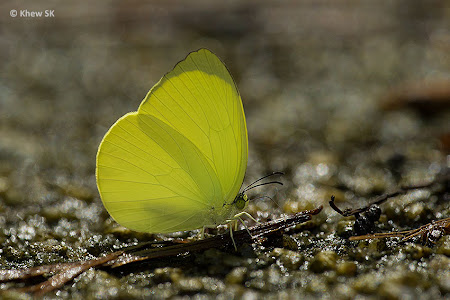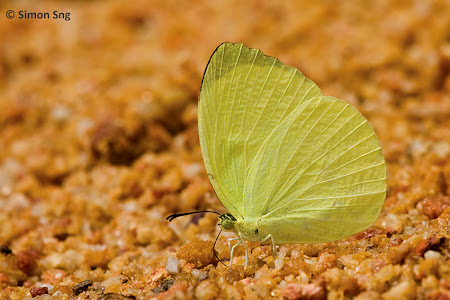An earlier version of the life history of the Malay Viscount can be found by clicking this link.
Butterfly Biodata:
Genus: Tanaecia Butler, 1869
Species: pelea Fabricius, 1787
Subspecies: pelea Fabricius, 1787
Wingspan of Adult Butterfly: 50-70mm
Local Caterpillar Host Plants: Palaquium obovatum (Sapotaceae), Pouteria obovata (Sapotaceae), Adinandra dumosa (Theaceae, common name: Tiup-Tiup).
A male Malay Viscount puddling on wet ground.
A sunbathing Malay Viscount.
Physical Description of Adult Butterfly:
On the upperside, the wings are pale greyish ochreous brown with submarginal arrow-shaped markings. On the forewing, these markings are embedded in large, whitish spots. On the underside , the wings are paler brown with a faint trace of violet in a side light. The two sexes can be distinguished in the hindwing: the male has two submarginal rows of small distinct, black V-shaped markings, whilst those in the female are very obscure and conjoint.
A male Malay Viscount enjoying the ripened fruit of the Singapore Rhododendron.
Another sunbathing Malay Viscount.
Field Observations of Butterfly Behaviour:
The Malay Viscount is rather common in Singapore. They are mainly found in the nature reserves, but at times adults can be seen flying in other forested areas. Both sexes have the habit of resting on perches with wings open, and visiting flowers/ripened fruits on flowering/fruiting trees in their habitat. The male have been observed to puddle on damp ground and on fallen (and rotting) fruits. The adults are skittish and readily take flight when disturbed.
Early Stages:
Locally three host plants have been recorded for the Malay Viscount so far, two Palaquium species in Sapotaceae and one Adinandra species in Theaceae. Caterpilars of the Malay Viscount feed on the middle-aged to mature leaves of these host plants.
Local host plant #1 : Adinandra dumosa (Tiup-Tiup).
Local host plant #2 : Palaquium obovatum.
A mating pair of the Malay Viscount.
A mother Malay Viscount laying an egg at a leaf tip of the host plant.
The eggs are laid singly at the leaf edge of the host plant. Each egg is dome-shaped with a base diameter of about 2mm. The surface is covered with large hexagonal depressions with hair-like protuberances emerging from adjoining corners. When freshly laid, the surface is moist and in pale green. Within hours, the moisture evaporates and the color turns to lime green.
Two views of an egg of the Malay Viscount.
Two views of a maturing egg of the Malay Viscount, one day prior to hatching.
After about 5 days, the 1st instar caterpillar emerges and proceeds to eat the eggshell as its first meal. The caterpillar is yellowish green in body colour and has a pale yellowish brown head capsule adorned with two brownish lateral stripes. Its body sports ten pairs of long and "fleshy" dorso-lateral protuberances. Black setae emanate from the body below these long protuberances and from a series of short dorsal protuberances. The caterpillar grows from an initial length of about 3.8mm to 6mm in about 2 days in this instar before the moult to the next instar takes place.
A newly hatched 1st instar caterpillar in the midst of eating the egg shel.
Two views of a 1st instar caterpillar, late in this stage, length: 5.3mm.
Two views of a late 1st instar caterpillar, dormant prior to its moult, length: 5.5mm
The body of the 2nd instar caterpillar is predominantly yellowish green. All ten pairs of short protuberances seen in the 1st instar have lengthened considerably. Each is projected horizontally with numerous branched spines and is almost always pressed to the leaf surface. The protuberance is whitish to very pale yellowish in color with some spines colored black. On the dorsum, pairs of white patches appear between the 2nd to the 10th protuberances. As growth progresses in this instar, each pair of white patches become conjoined to appear as an eye-shaped patch. The 2nd instar lasts for 3 days with the body length reaching about 9.5-10mm before the moult to the 3rd instar. (Note: The length given here and for later instars is measured between the head and the posterior end of the last body segment, excluding the length of protuberances.)
An early 2nd instar caterpillar, length: 6mm.
Two views of a 2nd instar caterpillar, late in this stage, length: 9.5mm.
Two views of a late 2nd instar caterpillar, dormant prior to its moult, length: 9.2mm.
The 3rd instar caterpillar is greenish in body color. Tiny whitish spots appears on each bod segment. The protuberances are greenish and have all become much longer in proportion. The branched spines appear almost like a bird's feather, with the secondary spines arranged neatly around the main spine. Dorsally the series of eight white-oultined patches become more prominent, and toward the later part of this instar, the central portion of each patch darkened to a deep shade of purple. The 3rd instar lasts for about 5 days and reaches a length of about 16-17mm before the next moult. Towards the end of this instar, the body color gradually changes to jade green.
A newly moulted 3rd instar caterpillar.
Two views of a 3rd instar caterpillar, late in this stage, length: 17mm.
Two views of a late 3rd instar caterpillar, dormant prior to its moult, length: 15mm.
The 4th instar caterpillar has a similar appearance as in the 3rd instar. Horizontal spines on each long protuberance are mostly whitish while shorter vertical spines are black in color. The eight dorsal marks becomes more shield-like in appearance with the central portion taken up by a large purplish/pinkish patch. After about 8 days in this instar, with its length reaching 25-26mm, the caterpillar moults to the 5th and final instar.
A newly moulted 4th instar caterpillar with its exuvia nearby.
Two views of a 4th instar caterpillar, length: 21mm.
Two views of a late 4th instar caterpillar, dormant prior to its moult, length: 26.5mm.
Essentially similar to the 4th instar caterpillar, the body of the 5th instar caterpillar is initially in lighter shade of green but gradually assuming a dark shade of green with a purplish tinge. There are noticeably more tiny whitish spots on the body compared to the 4th instar.
A newly moulted 5th instar caterpillar with its exuvia nearby.
Two views of a 5th instar caterpillar, length: 43mm.
A newly moulted 5th instar caterpillar with its exuvia nearby.
Two views of a 5th instar caterpillar, length: 43mm.
This final instar lasts for 7-8 days with the caterpillar reaching a mature length of about 41-43mm. On the last day, the caterpillar ceases its feeding activity and its body becomes shortened and decolorised to a pale yellowish coloration. It then seeks out a spot on the underside of a mature leaf and stays put. There it spins large quantity of silk threads to make a silk mound, to which its posterior claspers are then attached to. Now the pre-pupa hangs from this anchor point in a head-down posture. A short transverse white band appears on the dorsum about mid-body.
A late 5th instar caterpillar, with its body shortened and decolorised.
Two views of a pre-pupa of the Malay Viscount.
After about 1 day of the pre-pupal stage, pupation takes place. The pupa is suspended with its cremaster firmly attached to the silk mound. It has a smooth body which tapers steeply towards each end from a high transverse dorsal ridge which is lined with an interrupted golden transverse band. The green pupa has a series of rounded spots symmetrically arranged. These spots are initially creamy yellow but becoming golden about 1 day later. Two short golden-colored cephalic horns are also featured. Length of pupae: 18-20mm.
The pupation event of a Malay Viscount butterfly. [Change to HD or 4k video setting for best view quality.]
Two views of a newly formed pupa of the Malay Viscount.
Two views of a pupa of the Malay Viscount.
Nine days later, the pupa becomes considerably darkened, especially in the wing case area, signaling the end of the development of the adult still encased within. The next day, the adult butterfly ecloses and stays near the empty pupal case for an hour or two before taking its first flight.
Two views of a mature pupa of the Malay Viscount.
The eclosion event of a Malay Viscount butterfly. [Change to HD or 4k video setting for best view quality.]
Left: A newly eclosed female. Right: A newly eclosed male Malay Viscount.
References:
- [C&P4] The Butterflies of The Malay Peninsula, A.S. Corbet and H.M. Pendlebury, 4th Edition, Malayan Nature Society.
- Butterflies of Thailand, Pisuth Ek-Amnuay, 2nd Edition, 2012
- A Field Guide to the Butterflies of Singapore, Khew S.K., Ink On Paper Communications, 2010.















































































